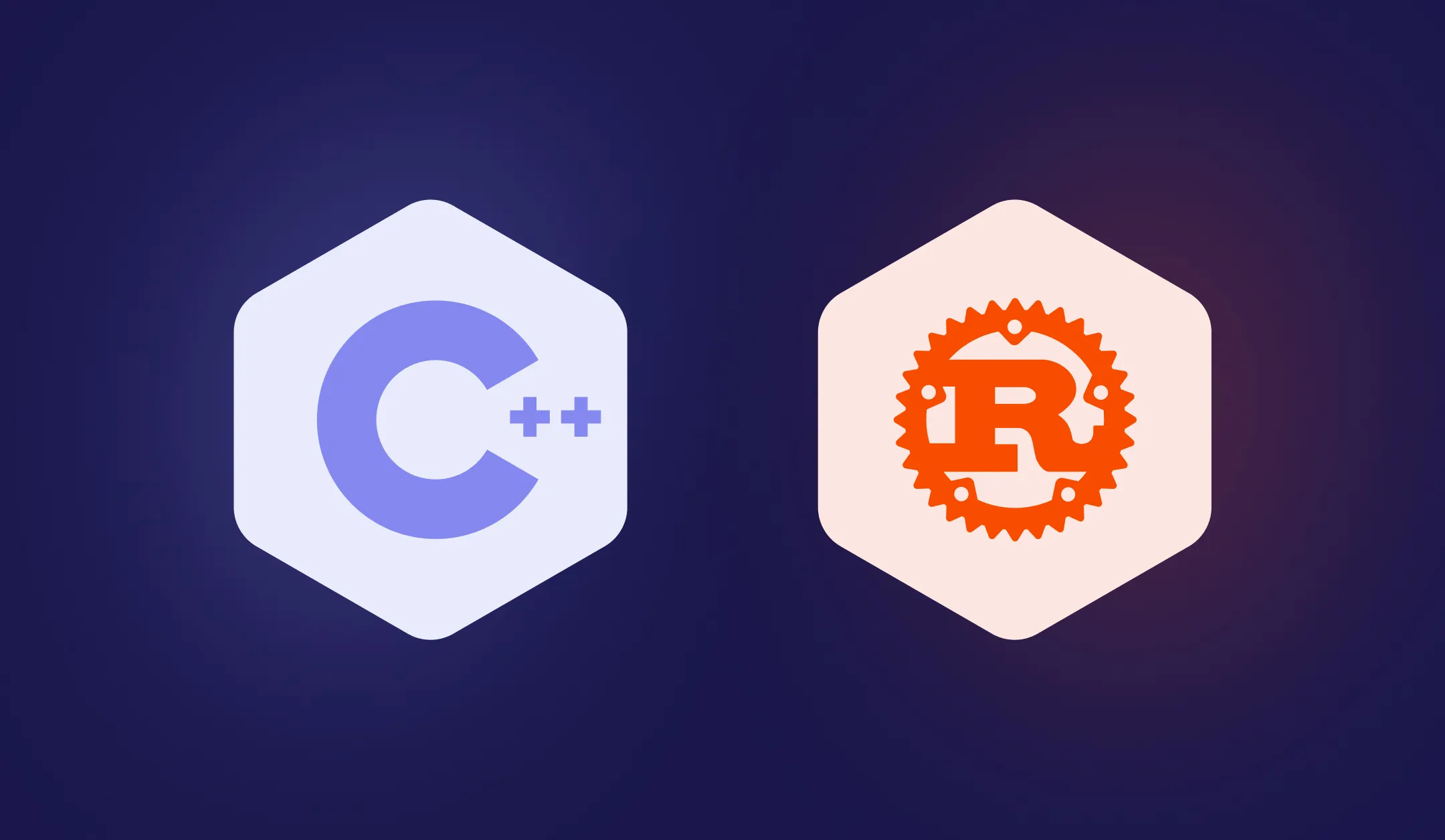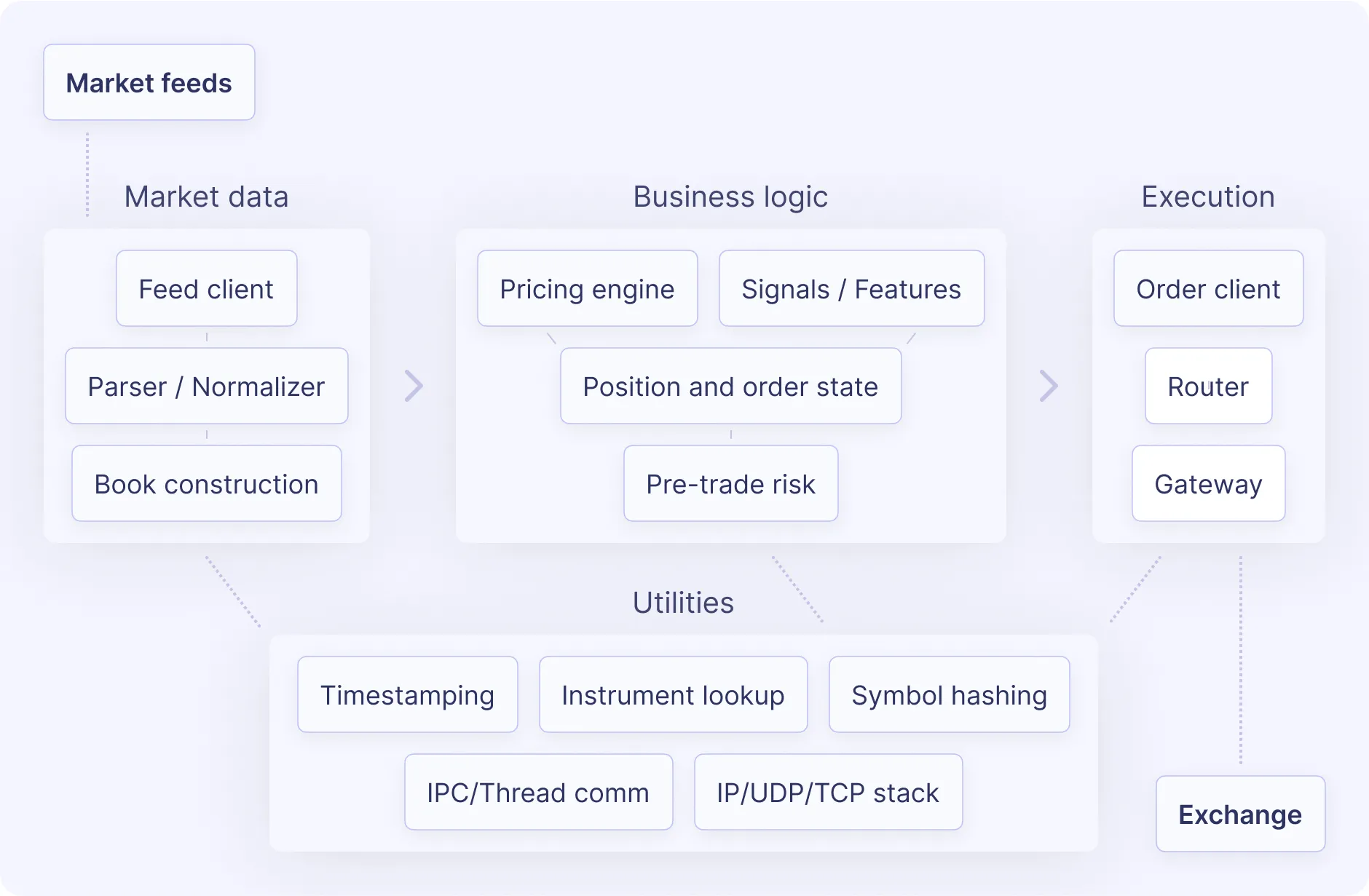Rust vs C++ for trading systems: lessons from building market data and trading products

Trading systems demand extreme performance, reliability, and precise control over hardware resources. In high-frequency trading (HFT), these requirements are even more pronounced. For decades, C++ has dominated this space, powering everything from market data feeds to execution engines. But Rust is increasingly appearing in production trading systems, offering comparable performance with additional safety guarantees. This comparison examines both languages through the lens of real-world trading system development.
C++ has become the de facto standard for trading systems due to its combination of performance characteristics and fine-grained control.
Vectorization boosts loop performance, while inlining and link-time optimization (LTO) can improve efficiency in a variety of contexts. Modern C++ compilers have decades of optimization techniques that can transform high-level code into extremely efficient machine code.
Choose exactly when and how to allocate, reuse, and free memory. This adds complexity but has performance benefits. Trading systems often use custom allocators, memory pools, and lock-free data structures to minimize allocation overhead that could impact latency.
Struct layout and container choice are under developer control, potentially improving locality and throughput. By carefully arranging data to match CPU cache lines and access patterns, developers can achieve significant performance gains in hot paths.
Threads, atomics, and condition variables allow control of parallel work without hidden scheduling overhead. Trading systems can pin threads to specific CPU cores, use lock-free programming techniques, and carefully orchestrate concurrent operations to maximize throughput while maintaining deterministic latency.
Beyond raw performance, C++ offers practical benefits that have cemented its position in the trading technology stack.
Mature compilers (GCC & Clang), sanitizers (ASAN), profilers (Valgrind), and more make it easier to diagnose issues. The ecosystem includes specialized tools for latency analysis, memory debugging, and performance optimization that are essential for trading system development.
Networking, serialization, and venue SDKs are widely available in C++ or via C bindings. Most exchanges provide native C++ APIs, and critical infrastructure components like FPGA interfaces and kernel bypass networking libraries target C++ first.
C++ has been a staple in universities and industry for decades, making hiring and onboarding easier. The deep pool of experienced C++ developers familiar with low-latency techniques provides a significant advantage for teams building trading systems.
It's relatively simple to use C with C++. Abstracted and performance-optimized C is often called from C++. This compatibility allows teams to leverage existing C code within C++ as they see fit, which saves time and effort.
While architectures differ by firm and strategy, many trading systems share a set of core components where C++ is often used. This chart highlights common components, though the exact boundaries and functions vary in real-world usage.

These components require microsecond-level latencies, deterministic performance, and the ability to process millions of messages per second. C++ provides the control necessary to meet these demanding requirements.
In production trading systems, Rust eliminates many memory issues and race conditions that can cause bugs and crashes. Rust's strengths for trading workloads come from characteristics that complement its memory safety guarantees.
Async and await support high-throughput networking for market data intake, session management, and batched order flow. Rust's async runtime can handle thousands of concurrent connections efficiently, making it well-suited for aggregating feeds from multiple venues.
Crates for networking, parsing, serialization, testing, and observability are mature. Developers can write high-quality code without custom infrastructure. The Rust ecosystem emphasizes correctness and performance, with many crates providing zero-cost abstractions.
When direct hardware access or specialized memory control is required, developers can isolate unsafe code in small modules and keep the rest in safe Rust. This approach maintains safety guarantees for most of the codebase while allowing performance-critical sections to use techniques like memory-mapped files or custom allocators.
Rust can be used for almost all of the same things as C++ and its performance is comparable in most benchmarks. Rust also has several advantages that make it increasingly attractive for trading systems.
Ownership and borrowing prevent null pointer dereferences, use-after-free, and buffer overflows at compile time. Strict concurrency rules prevent data races by default. These guarantees eliminate entire classes of bugs that can cause production outages in trading systems.
Traits, enums, and pattern matching with type inference enable developers to model complex trading logic more precisely. The type system can encode business rules and state machines, catching logic errors at compile time rather than in production.
Rust features easier integration and management of dependencies. It also has a standardized build system and project structure. Cargo handles dependencies, builds, testing, and documentation in a unified way, reducing the complexity of maintaining large trading systems.
Modern syntax with immutability by default and hygienic macros. Type inference keeps code concise. These features make Rust code easier to review and maintain, critical factors when dealing with complex trading algorithms and risk management logic.
Choosing a language is never a binary choice. Countless variables impact the decision, so it's important to use the language that's right for the job: one that fits the team, has the necessary libraries, and has acceptable tradeoffs.
It's also possible to combine the two languages. Rust and C++ can interact through C FFI, which makes it possible to rewrite one component at a time instead of the entire stack. This incremental approach allows teams to adopt Rust for new components while maintaining existing C++ infrastructure.
We do this at Databento today: Some services use Rust, some use C++, and they call each other in production. This hybrid approach leverages the strengths of both languages while managing migration risk.
Whether used independently or within the same stack, both languages will continue to remain pillars of reliable, high-performance systems in trading and beyond. The choice between them often comes down to specific requirements, team expertise, and whether the safety guarantees of Rust outweigh the mature ecosystem and talent pool of C++.